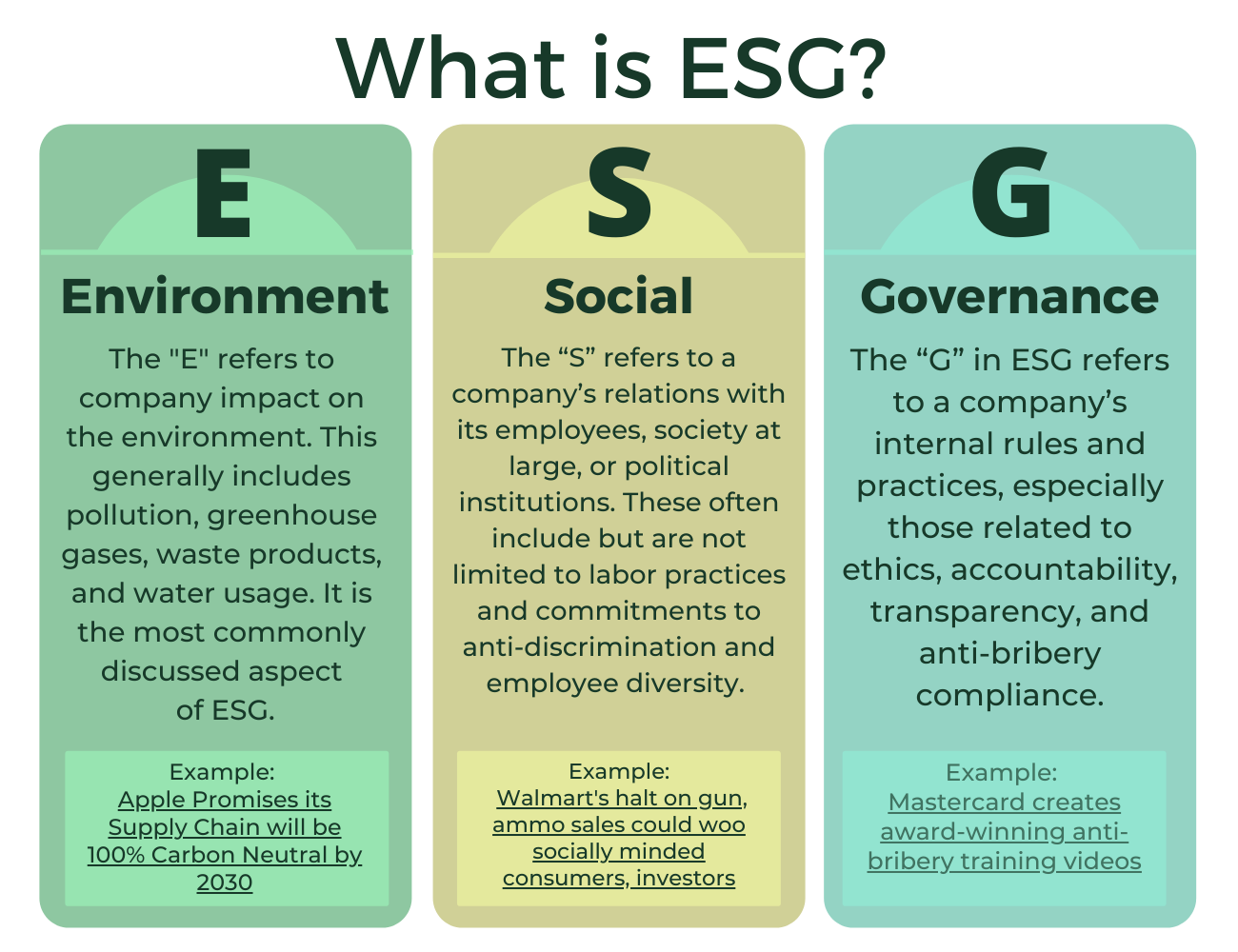ESG Regulation is Coming to Town

For close to a decade, business headlines have foretold the coming of a new regulatory behemoth under the non-threatening heading of ESG. Standing simply for environment, social, and governance, the acronym refers to new non-financial rules that many businesses will be required to follow. It is likely to be the biggest update to commercial regulation in history; the requirements will impel companies to take stronger measures to lessen their impact on the climate, prevent labor abuse and discriminatory workplace practices, and eliminate bribery and fraud in their operations and supply chains.
In theory, few are opposed to these changes. On the “E” front, the public has become more supportive of climate action in recent years, possibly due in part to the uptick in large-scale climate disasters that have validated the stark warnings of climate scientists. Consumers around the world also increasingly spend according to their values. In one recent survey, 72% of buyers said they more actively buy environmentally friendly products than they did five years ago, and big majorities say they prefer eco-friendly and socially responsible businesses.
However, changing consumer sentiment is not the main driver of corporate ESG enthusiasm. Nor is measuring how business contributes to social welfare a new idea. Thematically, ESG is similar to the popular corporate ethics approach of Corporate Social Responsibility, or CSR, which has emphasized the importance of a constructive relationship or “social contract” between society and business since the 1970s. But unlike CSR, ESG has also been driven by investor demands that businesses do more than philosophize about business-society relationships by providing hard data about how environmental, social, and governance-related factors are being followed in each company.
For their part, investors haven’t necessarily become more conscientious by asking for ESG disclosures. Rather, the financial consolidation of the world’s largest asset-owning firms has made investors more exposed to systemic risks in the global economy. As a 2019 report by the Harvard Business Review noted, “firms that have trillions of dollars under management…have become too big to let the planet fail.”
ESG Standards Forecast: Cloudy
Regulators are also supportive of ESG standards—and since the 2008 global financial crisis they have been even more concerned about systemic risks than investors. But creating new and comprehensive ESG rules has proved extremely difficult. On the one hand, ESG can cool the business cycle by reducing corporate “short-termism,” or incessant fixation on quarterly results and shareholder value, and encourage more long-term thinking about sustainability and employee well-being. On the other hand, writing a robust and inclusive list of dos and don’ts addressing the multiple dimensions of ESG—taking into account different business sectors, sizes, and circumstances—is a gargantuan task.
What has emerged instead is a loose patchwork of ESG-related rules, recommendations, guidance, voluntary standards, and proposals. But inconsistencies in approach and interpretation are still so large that the same company can receive different ESG scores depending on which firm does the evaluating. This has left more than a few business and government leaders confused.
A climate case helps illustrate. In 2010, the US Security and Exchange Commission (SEC) issued its first disclosure guidance related to climate change. When the SEC updated this guidance in 2021, Commissioners Hester M. Pierce and Elad L. Roisman released a statement where they addressed the question “What does this ‘enhanced focus’ on climate-related matters mean?” Their short answer: “It’s not yet clear.” Such ambiguity about guidance that has existed for over a decade is stunning. It should also moderate expectations about what pace of progress towards comprehensive ESG standards is possible in the short term.

Big Bucks
While the formulation of ESG standards has seemed to move at a snail’s pace, the growth of ESG-labeled investments has been exponential. According to Bloomberg, by the end of 2020, the amount of assets under management providing some kind of ESG monitoring totaled more than $35 trillion dollars—or over a quarter of total global assets—and will grow to $50 trillion by 2025. “E” or climate-friendly assets have grown even faster. At the recent UN Climate Change Conference, COP26, former Bank of England governor Mark Carney announced that $130 trillion in private sector assets had committed to achieving net-zero greenhouse gas emissions by 2050.
Such eye-popping growth in ESG-labeled assets before regulators have even decided what can be fairly considered “ESG” has led to accusations of opportunism and “greenwashing”. In a recent CIPE podcast, former Blackrock chief investment officer for sustainable investing Tariq Fancy criticized ESG investment labels as a “marketing narrative”.
“It’s being presented to the public as a sort of answer to Wall Street and asset managers… [As] not just good for the world, but good for investors. As a trained investor who looked across $9 trillion of assets…there’s a kernel of truth [to these claims]…but I think it’s gotten blown way out of proportion”.
Fancy’s concerns raise a serious question: If ESG factors represent non-financial aspects of a business’s operations, can ESG be socially responsible if Wall Street wants to use it as just another way to demand higher financial returns?
Also troubling are the internal contradictions within ESG itself. According to recent reporting by the Guardian, miners toiling in the Democratic Republic of the Congo have endured systematic abuse and paltry wages while extracting minerals destined for use in eco-friendly electric cars in Western countries. The case shows how the component elements of ESG are not necessarily self-reinforcing. Environmentally conscious businesses may be poorly governed or rely on socially irresponsible supply chains. Other companies may have high governance standards but score poorly on environmental impact.
Growing Consensus
Despite the contradictions, ambiguity, and sluggish progress towards universal standards, ESG proponents have momentum on their side. While the project remains immense, a raft of ESG-related announcements and initiatives have emerged in the last year across the business, political, and regulatory dimensions of ESG.
In the business sphere, the IFRS Foundation recently announced the creation of a new International Sustainability Standards Board (ISSB) to develop a global baseline of sustainability disclosure standards to meet investor requirements for ESG information. Done right, these baseline standards could help allay criticisms that ESG labels are more marketing than substance.
Meanwhile, the American Bar Association just launched an initiative to create and publicize “model contractual clauses” that support ethical labor practices and human rights. If successful, these clauses will help publicize ways for companies to meet their corporate human rights responsibilities, jumpstarting fulfillment of the “S” requirements in ESG.
In the political arena, ESG has received strong support from the US government. The Biden administration has created a new ESG Senior Policy Advisor position and installed ESG advocate Gary Gensler as the new chair of the Security Exchange Commission (SEC). Since assuming his post in April 2021, Gensler has described plans for a new Climate and ESG Task Force, asked public companies to make climate change disclosures a standard part of their SEC filings, and stated that new climate change disclosure rules would be announced in 2022.
Regulatory announcements about ESG have also accelerated. The SEC announced in April 2021 that it would publish a new risk alert distinguishing between “effective” and “deficient” practices among investment advisers, firms, and private funds offering ESG investing strategies. In October, the Labor Department adopted a rule making it easier for employers to offer workplace retirement investments that account for environmental, social, and governance information.
ESG initiatives are also emerging at the international level. In November 2021, an association of financial regulators from the U.S., Europe, Asia, and Latin America announced a global framework to monitor ESG investment ratings to battle ‘greenwashing’ in the private sector.
On the one hand, comprehensive ESG rules and standards are still in the realm of “coming soon”. On the other, the accelerated pace of ESG announcements reveals rising commitment by political leaders, businesses, and regulators to make ESG rules more substantial.
Laddering up to ESG
Executing ESG in today’s complex global economy will require more than momentum. The implementation challenges are real, and more must be done to align the understanding and expectations of investors, regulators, and businesses. Addressing the following issue areas will go a long way to help:
- Terminology: Eventually, everyone will need to speak the same language about ESG. This means more precise, mutually-agreed definitions for what E, S, and G factors are and how they should be benchmarked by businesses.
- Structure: Businesses and investors need a more uniform approach for implementing ESG compliance, including how information should be collected and disclosed and what explanation requirements should exist in cases where compliance isn’t possible.
- Fairness: Consideration must be made for how ESG rules will be enforced across different business sizes as well as different sectors, including those like extractive industries and defense manufacturers that may be particularly affected by them.
- Enforcement: As ESG rules emerge, businesses will need time to transition. Regulators in places like the Philippines have demonstrated how businesses can be encouraged to adopt sustainability reporting standards by slowly moving from voluntary ESG guidance, to disclosure requests that incur fines when they aren’t followed, and finally to mandatory compliance rules.
Finally, there is genuine hope that adopting ESG rules will help make business and investment decisions about more than just the financial bottom line. The Center for International Private Enterprise supports effective sustainability and corporate responsibility rules in order to reduce corruption, provide economic rewards for ethical businesses, and protect the planet’s future. ESG rules are good for people and for the planet. More broadly, they have the potential to strengthen society, increase trust in business, and bolster the foundations of democracy.
Shahrzad Majdameli is a visiting attorney with the International Network for Environmental Compliance and Enforcement (INECE) which is managed by the Environmental Law Institute (ELI) based in Washington, D.C. Since, 1969, ELI has played a crucial role in shaping the fields of environmental law and policy.
Ben Schmidt is an Associate Program Officer with the Anti-Corruption & Governance Center at the Center for International Private Enterprise. He has a Master’s Degree in Political Economy and Development.
Image Credit: Pixabay
